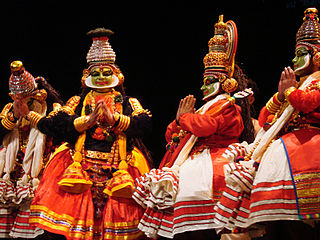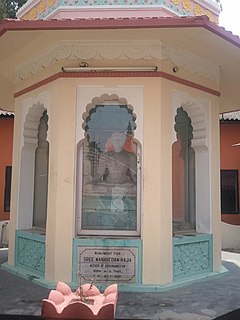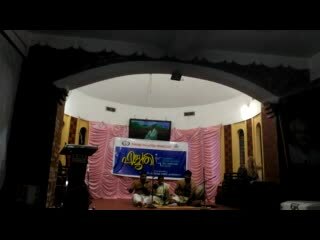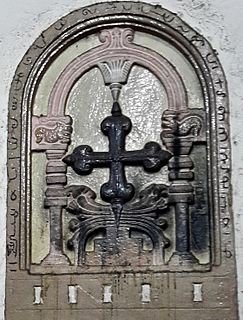 W
WThe culture of Kerala has developed over the past millennia, influences from other parts of India and abroad. It is defined by its antiquity and the organic continuity sustained by the Malayali people. Modern Kerala society took shape owing to migrations from different parts of India and abroad throughout Classical Antiquity.
 W
WAalavattam is a special decorative circular shield or fan that is held beneath both sides of respectable idols, deities or mythological characters during festivals and dances, especially in the state of Kerala in South India. The object is peculiar to the state of Kerala in India and the name originates from Malayalam (ml).
 W
WThe Agnicayana or Athirathram is a category of advanced Śrauta rituals.
 W
WThe Indian state Kerala is well known for its diverse forms of performing arts. The various communities in Kerala contribute to its rich and colorful culture.
 W
WChanganassery is a municipal town in Kottayam district in the state of Kerala, India. Changanassery is the gateway to the Western Ghats and Kuttanad. It is one of the major educational and religious centres of Kerala, with nearly 100% literacy. There are five colleges, eight higher secondary schools, one vocational higher secondary school and ten high schools within a four-kilometre radius of the town.
 W
WChavittu Nadakam (Malayalam:ചവിട്ടുനാടകം) is a highly colorful Latin Christian classical art form originated in Ernakulam district, Kerala state in India. Commonly believed that Fort Kochi is the birthplace of Chavittu Nadakam. It is noted for its attractive make-up of characters, their elaborate costumes, detailed gestures and well-defined body movements presented in tune with the rhythmic playback music and complementary percussion. This art form highly resembles European Opera. Chavittu Nadakam is believed to be originated during the 16th century AD. This form of play is prevalent among the Latin Christian community in the districts of Alappuzha, Ernakulam and Thrissur of Kerala.
 W
WThis article covers the role of elephants in the culture of Kerala state, southern India.
 W
WThe Embrandiri, also transliterated as Embranthiri, are a Malayali Brahmin subcaste of Tulu origin.
 W
WKakkarissi Natakam is a folk art form of Kerala state, India, originally from Tamil Nadu. This art form is more popular in the southern regions of Kerala. It is a form of musical drama and the language used is a blend of Tamil and Malayalam. Sundara Kakkan, Kakkathis, Vedan, Thampuraan, etc. are the main characters in this art form. Play is performed with dance steps and songs. Mrudangam, Harmonium, Ganchira, Chenda and Kaimani are the main musical instruments used. The story is premised around Lord Shivan with his consort Parvathi Devi who arrived to earth in the form of Kakkalan and Kakkathi, a nomadic tribe of fortune tellers.
 W
WKalaripayattu, also known simply as Kalari, is an Indian martial art that originated in modern-day Kerala, a state on the southwestern coast of India. Kalaripayattu is known for its long-standing history within Indian martial arts. It is believed to be the oldest surviving martial art in India, with a history spanning over 3,000 years.
 W
WFollowing is a list of Kalaripayattu practitioners.
 W
WKerala Day also referred to as Kerala Piravi, marks the birth of the state of Kerala in southern India. The state of Kerala was created on 1 November 1956, long after the Independence of India. Before this, it was three major provinces and several outlying regions under various rulers.
 W
WThe Kerala Sahitya Akademi or Academy for Malayalam literature is an autonomous body established to promote the Malayalam language and literature. It is situated in City of Thrissur, Kerala in India.
 W
WKerala Tulu Academy is an organisation under Government of Kerala which opened in 2007. The purpose of the academy is to preserve and promote Tulu language, Tulu script, Tulu literature and Tulu culture. It is located in Hosangadi in Kasargod district, Kerala which has a considerable population of Tulu speakers, a language minority in the state. The academy was inaugurated by then Chief Minister V. S. Achuthanandan. The academy is planned to set up its office in Durgippalla near Hosangadi in Kasargod district, Kerala.
 W
WKrishnaattam is a temple art in Kerala, India. It is a dance drama and presents the story of Krishna in a series of eight plays and was created by Manaveda, the then Zamorin Raja of Calicut in northern Kerala. The eight plays are: Avataram, Kaliyamardanam, Rasakrida, Kamsavadham, Swayamvaram, Banayuddham, Vividavadham and Swargarohanam. It survives in its glory at the Guruvayur Sri Krishna temple.
 W
WKuttiyum kolum is a traditional game played in Kerala, India. It is similar to an ancient game found all over the Indian Subcontinent with different names, such as Gilli-danda in North India. A similar game by the name of Lippa has been played in Italy. Kuttiyum kolum possibly originated over 2500 years ago.
 W
WMalayalam Calendar or Kollam Era is a solar and sidereal Hindu calendar used in Kerala. The origin of the calendar has been dated as 825 CE.
 W
WManaveda (Malayalam മാനവേദന്, the Zamorin Raja of Calicut in northern Kerala is renowned as author of Krishnanattam.It is a dance drama and presents the story of Krishna in a series of eight plays.
 W
WManikandapuram was the capital of the Kingdom of Thekkumkur. Manikandapuram is a part of Vakathanam Gramam in the Changanassery Taluk of Kottayam District. At the beginning of the Thekkumkur princely state, the nearest place, Vennimala was established as the headquarters. Vennimala was the most secure place for the enemy. The forests were cut down and developed into habitable areas and the administration is strengthened by the capital city of Manikandapuram.
 W
WNaranath Branthan is a character in Malayalam folklore. He was considered to be a divine person, a Mukhta who pretended to be mad. His chief activity consisted of rolling a big stone up a hill and then letting it fall back down. There is a large statue of Naranath in Pattambi, Palakkad district of Kerala where he is believed to have lived.
 W
WNilavilakku is a traditional lamp used commonly in Kerala as well as in Tamil nadu. The traditional lamps which is lit during every auspicious occasions; in temples before the worship starts; at the official and unofficial functions.
 W
WPaambadam is an earring worn by elderly women in South Indian States such as Tamil Nadu & Kerala.
 W
WPadmanabhapuram is a town and a municipality near Thuckalay in Kanyakumari district in the Indian state of Tamil Nadu. As of 2011, the town had a population of 21,342.
 W
WPanchari Melam is a percussion ensemble, performed during temple festivals in Kerala, India. Panchari Melam, is one of the major forms of chenda melam, and is the best-known and most popular kshetram vadyam genre. Panchari melam, comprising instruments like chenda, ilathalam, kombu and kuzhal, is performed during virtually every temple festival in central Kerala, where it is arguably presented in the most classical manner. Panchari, however, is also traditionally performed, with a touch of subtle regional difference, in north (Malabar) and south-central Kerala (Kochi). Of late, its charm has led to its performance even in deep-south Kerala temples.
 W
WPoothan and Thira is a ritualistic art form found in the South Malabar region of Kerala in India, in which people dance in costumes representing Poothan, Shiva's lieutenant, and Thira, the goddess Kali, to the accompaniment of drummers.
 W
WPulluvan Pattu is a form of serpent worship performed by both the lower castes and higher castes, in addition to serpent temples. The pulluvar of Kerala are closely connected to serpents. They consider the snake gods their presiding deities and perform sacrifices and sing songs.
 W
WThe Saint Thomas Christian denominations are traditional Christian denominations from Kerala, India, who trace their origins to the evangelistic activity of Thomas the Apostle in the 1st century. They are also known as "Nasranis" as well. The Syriac term "Nasrani" is still used by St. Thomas Christians in Kerala.
 W
WThe Slama Carol or Slama Kali is a Christian traditional musical artform that originated in the coastal areas of Alappuzha and Cochin in Kerala, India.
 W
WTharavad is a Malayalam word for ancestral home, usually used as the common house for the joint family system practised by Nairs, Ambalavasis and Namboothris of Kerala, India. Hermann Gundert in his Malayalam—English dictionary published in 1872, lists tharavad as "ancestral residence of land-owners" and also as "a house, chiefly of noblemen". Contemporary usage of the word is now more generic to all social classes.